Programs in Szigetköz
Places of interest in Hédervár
Hédervár is a settlement in Szigetköz, half way between Mosonmagyaróvár and Győr. The area has been inhabited ever since the Bronze Age. Knight Héder received as a donation all this area containing Szigetköz and Csallóköz in the time of Géza II. It is highly probable that Héder has established the family of Héderváry. One of the most famous descendants of the Héderváry family is István Héderváry Kont, who appears in legends as a freedom fighter and hero, and participated in the conspiracy against king Sigismund of Luxemburg. He helped Károly Kis, therefore he was executed in 1393 together with thirty-three of his fellow conspirators. The Kont-tree was planted in his memory. Another member of the family, Bishop János Héderváry of Győr has built the Héderváry chapel next to the Basilica in Győr.
Famous sights in Hédervár:
Khuen-Héderváry-castle
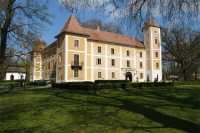 The castle has served as a dwelling place for the count’s family for centuries. In the 15th century it was a building surrounded by bastions and moat, but in 1710 it was renovated and turned into a castle. It was renovated again in 1987, and since then characteristic marks of different ages can be recognized on the building. (Its parts are: Sala Terrana, chapel, knights’ hall, library). There are more than 60 species of trees in the 8 ha park surrounding the castle. It is interesting to mention that the castle, which is situated in the middle of the Szigetköz, half-way between Mosonmagyaróvár and Győr, has three towers. According to legends, the castle is situated at the meeting point of three counties, Győr, Pozsony and Moson, and each of the castle’s tower stands in a different county.
The castle has served as a dwelling place for the count’s family for centuries. In the 15th century it was a building surrounded by bastions and moat, but in 1710 it was renovated and turned into a castle. It was renovated again in 1987, and since then characteristic marks of different ages can be recognized on the building. (Its parts are: Sala Terrana, chapel, knights’ hall, library). There are more than 60 species of trees in the 8 ha park surrounding the castle. It is interesting to mention that the castle, which is situated in the middle of the Szigetköz, half-way between Mosonmagyaróvár and Győr, has three towers. According to legends, the castle is situated at the meeting point of three counties, Győr, Pozsony and Moson, and each of the castle’s tower stands in a different county.
Chapel of the Virgin Mary
The chapel was built at the beginning of the 15th century and it has been the traditional burial place of the Héderváry family. Héderváry Katalin has transformed it in the 15th century and made it into a place of worship dedicated to the Virgin Mary. There are beautifully decorated tombstones in the wall of the chapel, and the interior is neo-gothic. The funerary urns in the chapel contain the hearts of the female members of the family. The Loretto chapel was built in the 17th century. It was also renovated in 1994..
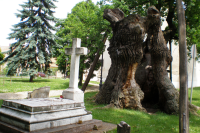 Monument of Count Khuen-Héderváry
Monument of Count Khuen-Héderváry
It is the final resting place of the last members of the Héderváry dynasty. Count Károly Khuen-Héderváry, ban of Croatia and Slovenia, founding member of the National Workers’ Party is buried here. The last person to be buried here was his son, Károly.
Árpád-tree (Árpád-oak tree)
This is an approx. 700 year old oak tree situated next to the Chapel of the Virgin Mary. Legend has it that even the impression of the tether on Árpád’s horse, which he used to tie his horse to the tree, can be seen on the trunk. Circumference of the oak tree is 720 cm, its maximum diameter is 235 cm, and it is 14 m high.
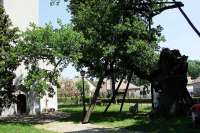 Kont-tree
Kont-tree
300 meters to the south-east from the castle is the poplar planted in memory of István Héderváry Kont. The family and the local community has been protecting and looking after this monument for centuries. The legend of the bread turned into stone is also connected to this place.
Saint Michael Catholic church
The baptising font in the church is made of red marble, its high altar has been made by Zallinger, and its side altar is named after Saint John of Nepomuk.
Statue of the Colorado-beetle
In 1997, two young artists, Mihály Búzás and József Szolnoki, have made a film about the Colorado-beetle for the Mediawave Festival in Győr. It was exactly fifty years from the first appearance of the Colorado-beetle in Hungary. The first Colorado-beetle in Hungary was spotted here in Hédervár. Another three young artists, Maráczy Manuela, Zsédely Teréz and Csáki László have made a bronze statue of the Colorado-beetle, and they put the statue opposite the parish hall on a base made of red marble.
Famous sights in Hédervár:
Khuen-Héderváry-castle
 The castle has served as a dwelling place for the count’s family for centuries. In the 15th century it was a building surrounded by bastions and moat, but in 1710 it was renovated and turned into a castle. It was renovated again in 1987, and since then characteristic marks of different ages can be recognized on the building. (Its parts are: Sala Terrana, chapel, knights’ hall, library). There are more than 60 species of trees in the 8 ha park surrounding the castle. It is interesting to mention that the castle, which is situated in the middle of the Szigetköz, half-way between Mosonmagyaróvár and Győr, has three towers. According to legends, the castle is situated at the meeting point of three counties, Győr, Pozsony and Moson, and each of the castle’s tower stands in a different county.
The castle has served as a dwelling place for the count’s family for centuries. In the 15th century it was a building surrounded by bastions and moat, but in 1710 it was renovated and turned into a castle. It was renovated again in 1987, and since then characteristic marks of different ages can be recognized on the building. (Its parts are: Sala Terrana, chapel, knights’ hall, library). There are more than 60 species of trees in the 8 ha park surrounding the castle. It is interesting to mention that the castle, which is situated in the middle of the Szigetköz, half-way between Mosonmagyaróvár and Győr, has three towers. According to legends, the castle is situated at the meeting point of three counties, Győr, Pozsony and Moson, and each of the castle’s tower stands in a different county.Chapel of the Virgin Mary
The chapel was built at the beginning of the 15th century and it has been the traditional burial place of the Héderváry family. Héderváry Katalin has transformed it in the 15th century and made it into a place of worship dedicated to the Virgin Mary. There are beautifully decorated tombstones in the wall of the chapel, and the interior is neo-gothic. The funerary urns in the chapel contain the hearts of the female members of the family. The Loretto chapel was built in the 17th century. It was also renovated in 1994..
 Monument of Count Khuen-Héderváry
Monument of Count Khuen-Héderváry It is the final resting place of the last members of the Héderváry dynasty. Count Károly Khuen-Héderváry, ban of Croatia and Slovenia, founding member of the National Workers’ Party is buried here. The last person to be buried here was his son, Károly.
Árpád-tree (Árpád-oak tree)
This is an approx. 700 year old oak tree situated next to the Chapel of the Virgin Mary. Legend has it that even the impression of the tether on Árpád’s horse, which he used to tie his horse to the tree, can be seen on the trunk. Circumference of the oak tree is 720 cm, its maximum diameter is 235 cm, and it is 14 m high.
 Kont-tree
Kont-tree300 meters to the south-east from the castle is the poplar planted in memory of István Héderváry Kont. The family and the local community has been protecting and looking after this monument for centuries. The legend of the bread turned into stone is also connected to this place.
Saint Michael Catholic church
The baptising font in the church is made of red marble, its high altar has been made by Zallinger, and its side altar is named after Saint John of Nepomuk.
Statue of the Colorado-beetle
In 1997, two young artists, Mihály Búzás and József Szolnoki, have made a film about the Colorado-beetle for the Mediawave Festival in Győr. It was exactly fifty years from the first appearance of the Colorado-beetle in Hungary. The first Colorado-beetle in Hungary was spotted here in Hédervár. Another three young artists, Maráczy Manuela, Zsédely Teréz and Csáki László have made a bronze statue of the Colorado-beetle, and they put the statue opposite the parish hall on a base made of red marble.
Lipót (distance from Hédervár: 5 km)
When you are visiting Lipót, it is worth stepping by the Saint Clement church. It is famous for its Maulbertsch fresco. You could also take a long and romantic walk on the road connecting Lipót and Darnózseli. The beautiful row of protected horse-chestnut trees will provide you shadow and guide your way on a hot summer day.
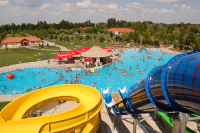 The area of the Lipót Thermal Bath used to be an agricultural area until 1967 when thermal water was discovered here. At the beginning, thermal water was used for heating the greenhouses. The bath opened in 1968. It had only two pools at that time. The bath is open every day and it is even popular during winter. Its water was declared and qualified as healing water in 2004.
The area of the Lipót Thermal Bath used to be an agricultural area until 1967 when thermal water was discovered here. At the beginning, thermal water was used for heating the greenhouses. The bath opened in 1968. It had only two pools at that time. The bath is open every day and it is even popular during winter. Its water was declared and qualified as healing water in 2004.
The bath is situated in a calm, beautiful natural environment. It has two pools with healing water, a swimming pool, a swimming pool for kids, a whirling corridor, jacuzzi, a pool full of massage elements, a beach pool of 1,200 m² (which contains a wave pool, a water amusement park and huge slides). There is also a sauna situated in a watermill on a separate small island.
 The area of the Lipót Thermal Bath used to be an agricultural area until 1967 when thermal water was discovered here. At the beginning, thermal water was used for heating the greenhouses. The bath opened in 1968. It had only two pools at that time. The bath is open every day and it is even popular during winter. Its water was declared and qualified as healing water in 2004.
The area of the Lipót Thermal Bath used to be an agricultural area until 1967 when thermal water was discovered here. At the beginning, thermal water was used for heating the greenhouses. The bath opened in 1968. It had only two pools at that time. The bath is open every day and it is even popular during winter. Its water was declared and qualified as healing water in 2004.The bath is situated in a calm, beautiful natural environment. It has two pools with healing water, a swimming pool, a swimming pool for kids, a whirling corridor, jacuzzi, a pool full of massage elements, a beach pool of 1,200 m² (which contains a wave pool, a water amusement park and huge slides). There is also a sauna situated in a watermill on a separate small island.
Lébény (distance from Hédervár: 19 km)
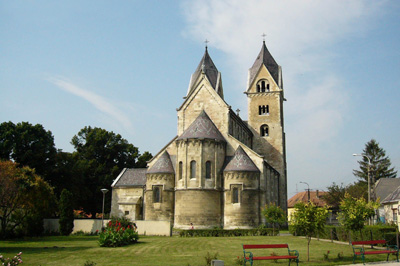 The church in Lébény is an abbey church in Roman style built from funding donated by the Héderváry family. In 1208 the church was donated to the Benedictine monks. They moved from here to Pannonhalma later on. The floor plan of the church is directed to the east, with three naves, without cross aisle, and with semi-circle shaped chancels set on a straight line in each nave. Its construction is basilica like, with cross arches and two western towers, loft for the advowees, a main and a southern entrance gate. The lower parts of the towers were connected directly into the church, but one of them was bricked up due to the stairs built later inside the northern tower. It has a characteristic style with small embrasures and round shaped – not too elaborated – rose windows.
The church in Lébény is an abbey church in Roman style built from funding donated by the Héderváry family. In 1208 the church was donated to the Benedictine monks. They moved from here to Pannonhalma later on. The floor plan of the church is directed to the east, with three naves, without cross aisle, and with semi-circle shaped chancels set on a straight line in each nave. Its construction is basilica like, with cross arches and two western towers, loft for the advowees, a main and a southern entrance gate. The lower parts of the towers were connected directly into the church, but one of them was bricked up due to the stairs built later inside the northern tower. It has a characteristic style with small embrasures and round shaped – not too elaborated – rose windows.Halászi (distance from Hédervár: 13 km)
The inhabitants of this small village were the main suppliers of fish to the royal court. The settlement was turned into a fishing village in the 13th century.
Two houses built in characteristic peasant baroque style can be seen next to the church. Characteristic motives of the peasant baroque style are the rendered or painted frontispiece on which the year the house was built as well as the initials of the owner can be seen. In some cases there can also be some flower patterns on the frontispiece. There are small bays on the main side of the house. The owners used to put statues of saints in these by which they symbolized their religion.
Two houses built in characteristic peasant baroque style can be seen next to the church. Characteristic motives of the peasant baroque style are the rendered or painted frontispiece on which the year the house was built as well as the initials of the owner can be seen. In some cases there can also be some flower patterns on the frontispiece. There are small bays on the main side of the house. The owners used to put statues of saints in these by which they symbolized their religion.
Dunasziget (distance from Hédervár: 19 km)
Dunasiget was created in 1969 from three smaller settlements, Cikolasziget, Doborgazsziget and Sérfenyősziget. The branches of the river Danube have nearly no drifting in this area, so these anabranches of the river could be ideal for practicing rowing even for beginners.
When you visit Dunasziget, it is worth to stop by the Ökopark established in 2006 and the Dunasziget Education and Research Centre. The park gives a new approach to presenting the Szigetköz area. Specialized guided tours provide opportunity for walks, beaver lurking and experiencing different crafts.
When you visit Dunasziget, it is worth to stop by the Ökopark established in 2006 and the Dunasziget Education and Research Centre. The park gives a new approach to presenting the Szigetköz area. Specialized guided tours provide opportunity for walks, beaver lurking and experiencing different crafts.
Dunakiliti (distance from Hédervár: 27 km)
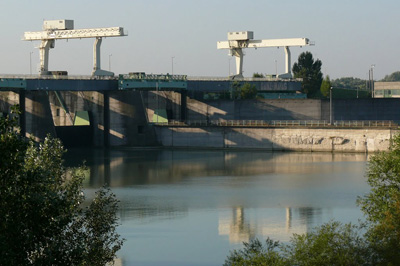 The settlement used to have serious industrial and agricultural production. In the 12th century, the Danube was probably running where today the main road is. One of the sights to visit in Dunakiliti is the millennial oak tree planted in 1896. The Batthyány family purchased the area at the beginning of the 19th century. The “doctor of the poor”, László Battyhyányi-Strattmann spent his first 6 years here. His mother had his statue made as a commemoration of 100 years from the plague. In 2003 László Battyhyányi-Strattmann was beatified. The castle is a school nowadays. A commemorative room was kept in his memory.
The settlement used to have serious industrial and agricultural production. In the 12th century, the Danube was probably running where today the main road is. One of the sights to visit in Dunakiliti is the millennial oak tree planted in 1896. The Batthyány family purchased the area at the beginning of the 19th century. The “doctor of the poor”, László Battyhyányi-Strattmann spent his first 6 years here. His mother had his statue made as a commemoration of 100 years from the plague. In 2003 László Battyhyányi-Strattmann was beatified. The castle is a school nowadays. A commemorative room was kept in his memory.In 1977 Czechoslovakia and Hungary signed an agreement to build a barrage and a common dam lake on the river Danube. In 1978 work was started on the project. The aim was to build a power plant in Nagymaros. This plant would have regulated the water level in the Szigetköz area. Following the change of regime in 1989 work was suspended in Nagymaros. The pretext was that the plant would disturb the natural environment and ecological balance of the area. The Slovak partner decided to continue and finish the building. The power plant at Bős was temporarily put into operation. The Slovak partner diverted the Danube on 25th of October 1992 between the settlements Rajka and Szab. They started the building works on the Danube channel. This has completely changed the river regime in Szigetköz. The water level decreased significantly. In 1995 work was started on the ground sill. The aim was to be able to regulate the water level.
Beside water sports, the golf course of the Pogány castle provides excellent opportunity for tourists to do sports. You can practice golf here on the 14-hectare area of the 9-hole golf pitch. There is a separate club house for golfers here. The clubhouse has a drink bar and locker rooms as well. Subject to prior agreement, professional golf trainers are also available to teach you the basics of golf, or to help you reach a higher level of your golf knowledge.
Feketeerdő (distance from Hédervár: 31 km)
When you are visiting Feketeerdő, it is worth to stop by Csaba Grózer. He is a master of traditional bow making. He prepares many types of bows, with huge expertise and passionate commitment.
Mosonmagyaróvár (distance from Hédervár: 19 km)
The town used to be the main city in Moson county. At the time it was part of the Roman Empire, it was known by the name Ad Flexum. Queen Elisabeth gave the settlement its town status in 1354. Until 1939 the town was made up of two separate settlements: Moson and Magyaróvár. The thermal water discovered here was declared and qualified as healing water in 1967. Ever since it first opened in 1969 the town’s thermal bath has been very popular among health conscientious tourists.
Mosonmagyaróvár is situated at the confluence of the Lajta and the Moson-Danube. Several branches of the Lajta cross the town. However, the town is not known throughout Europe for its natural resources but for the health tourism, mainly for dental treatments. A huge advantage for foreign tourists is that they can be treated for half the price the same treatment would cost in their home countries. Due to the huge demand, the number of dental cabinets is over 100.
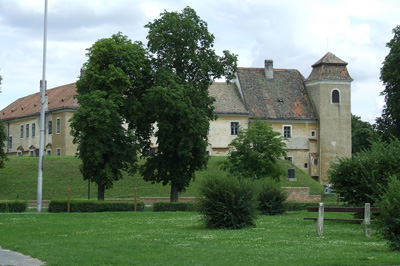 The oldest monument in the town is the castle. The building was surrounded by a moat. You can get into the castle through a bridge made of bricks and a gate-building shaped like a tunnel. The seven gothic sediles served the defenders of the castle. We do not know exactly when the castle was built, but it was reinforced several times. Since there was no source for stones in the area, the building was reinforced by decreasing its height. Its shape must have been a pentagon, but today only an irregular rectangle shape can be seen. The ground floor and the first floor are in baroque style. The second floor was erected for the planned Educational Institute for Economics. The fortress and its surrounding were owned by the Habsburg family. Europe's first agricultural college was established and organized by Kázmér Albert prince of Saxony. The College has functioned more or less continuously through the years. The aim of Kázmér Albert was to provide good education for the people working in his fields. At the entrance of the fortress you can see two busts donated by the local Economist Association. On the left is the bust of the founder Kázmér Albert prince of Saxony, on the right is the bust of the first director, Antal Wittmann.
The oldest monument in the town is the castle. The building was surrounded by a moat. You can get into the castle through a bridge made of bricks and a gate-building shaped like a tunnel. The seven gothic sediles served the defenders of the castle. We do not know exactly when the castle was built, but it was reinforced several times. Since there was no source for stones in the area, the building was reinforced by decreasing its height. Its shape must have been a pentagon, but today only an irregular rectangle shape can be seen. The ground floor and the first floor are in baroque style. The second floor was erected for the planned Educational Institute for Economics. The fortress and its surrounding were owned by the Habsburg family. Europe's first agricultural college was established and organized by Kázmér Albert prince of Saxony. The College has functioned more or less continuously through the years. The aim of Kázmér Albert was to provide good education for the people working in his fields. At the entrance of the fortress you can see two busts donated by the local Economist Association. On the left is the bust of the founder Kázmér Albert prince of Saxony, on the right is the bust of the first director, Antal Wittmann.
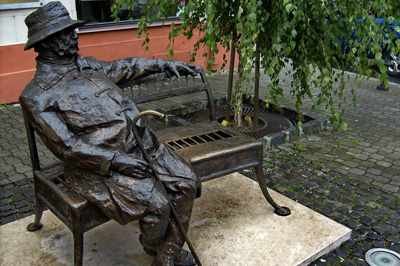 Deák square was once the market square of Magyaróvár. From the east it is bordered by the mill and the three storey high building of the brewery. The mill is one of the oldest buildings of the town. It was open and working until 1980. The brewery was bought by the Dreher beer-manufacturing company in 1937. It was closed later on. On the other side of the square is the Habsburg palace with its baroque arches in the court. Friedrich Maria Albrecht Wilhelm Karl von Österreich lived in the building from 1920 with his family. Nowadays it houses a Piarist friary and a school. Friedrich of Habsburg lived in this building between 1920 and 1936. He was a very friendly person. As he took long walks every day he stopped and discussed with pedestrians while he was sitting on the bench in front of the palace. For this reason the people of Mosonmagyaróvár remembered him by placing a sitting sculpture of the Archduke on a wedlock bench. The statue was finished in 2006. Another gem of the square is St. John of Nepomuk’s Baroque statue consisting of three figures. St. John of Nepomuk is considered the patron of Czechia. St. John of Nepomuk is considered the first martyr of the seal of the confession.
Deák square was once the market square of Magyaróvár. From the east it is bordered by the mill and the three storey high building of the brewery. The mill is one of the oldest buildings of the town. It was open and working until 1980. The brewery was bought by the Dreher beer-manufacturing company in 1937. It was closed later on. On the other side of the square is the Habsburg palace with its baroque arches in the court. Friedrich Maria Albrecht Wilhelm Karl von Österreich lived in the building from 1920 with his family. Nowadays it houses a Piarist friary and a school. Friedrich of Habsburg lived in this building between 1920 and 1936. He was a very friendly person. As he took long walks every day he stopped and discussed with pedestrians while he was sitting on the bench in front of the palace. For this reason the people of Mosonmagyaróvár remembered him by placing a sitting sculpture of the Archduke on a wedlock bench. The statue was finished in 2006. Another gem of the square is St. John of Nepomuk’s Baroque statue consisting of three figures. St. John of Nepomuk is considered the patron of Czechia. St. John of Nepomuk is considered the first martyr of the seal of the confession.
The Cselley-house is the oldest monument building in Mosonmagyaróvár. The building houses the Gyurkovics-collection, which is made up of fine arts and porcelain items. The collection contains 160 paintings from famous painters like Munkácsy and Rippl-Rónai. The Cselley house is part of the Hansági Museum and houses a collection of applied industrial art as well as a Roman lapidary with several tombstones.
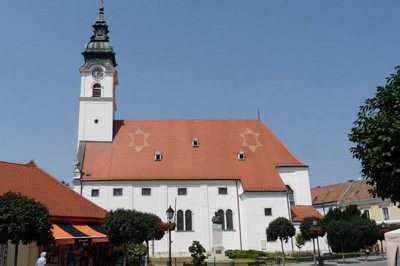 Saint Gotthárd church is an important architectural monument. It was named after an old Bavarian saint. In the nave under the church is the Habsburg-crypt, which is the burial place of the last members of the archduke branch of the family. The crypt has six bays. There are four bells in the tower. These are rather new since the old bells were melted and used for making cannons during the war. One of the mostly decorated parts of the church is the baroque high altar with Corinthian columns, frontispiece in form of a lute, and a group of large sized statues. The high altar is made up of three parts. The statue of the Virgin Mary is situated in the middle of the altar. The upper part of the lute is decorated with the statue of Saint Gotthárd. The gold plated pulpit of the church is decorated with reliefs and statues. The side-altars are dedicated to the lives of Saint Stephen, the Virgin Mary, Christ, the Three Kings and Saint John of Nepomuk.
Saint Gotthárd church is an important architectural monument. It was named after an old Bavarian saint. In the nave under the church is the Habsburg-crypt, which is the burial place of the last members of the archduke branch of the family. The crypt has six bays. There are four bells in the tower. These are rather new since the old bells were melted and used for making cannons during the war. One of the mostly decorated parts of the church is the baroque high altar with Corinthian columns, frontispiece in form of a lute, and a group of large sized statues. The high altar is made up of three parts. The statue of the Virgin Mary is situated in the middle of the altar. The upper part of the lute is decorated with the statue of Saint Gotthárd. The gold plated pulpit of the church is decorated with reliefs and statues. The side-altars are dedicated to the lives of Saint Stephen, the Virgin Mary, Christ, the Three Kings and Saint John of Nepomuk.
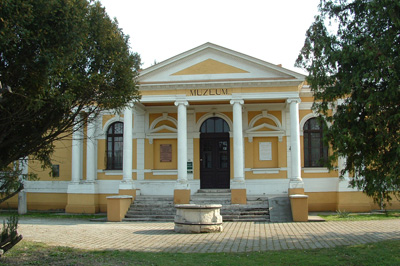 The Hanság Musem in Mosonmagyaróvár is one of the oldest museums in Hungary. Its first permanent exhibition opened in 1921. Unfortunately most of the collection was destroyed in WWII, but it was reopened soon following demands of local people. Its archaeological collection is made up of items found during excavations made in the area. There are findings from the Bronze Age, and some cemeteries were also found. It has a large collection of ethnographical items. This is the result of research made in the thirties. You can get a glimpse at tools and items connected to traditional crafts in the area like gold-digging, fishing and hunting, as well as traditional furniture and everyday objects from local houses. Donations from local people helped to enlarge the collection presenting local traditions and traditional way of life. Donations made by local craftsmen are the most valuable items.
The Hanság Musem in Mosonmagyaróvár is one of the oldest museums in Hungary. Its first permanent exhibition opened in 1921. Unfortunately most of the collection was destroyed in WWII, but it was reopened soon following demands of local people. Its archaeological collection is made up of items found during excavations made in the area. There are findings from the Bronze Age, and some cemeteries were also found. It has a large collection of ethnographical items. This is the result of research made in the thirties. You can get a glimpse at tools and items connected to traditional crafts in the area like gold-digging, fishing and hunting, as well as traditional furniture and everyday objects from local houses. Donations from local people helped to enlarge the collection presenting local traditions and traditional way of life. Donations made by local craftsmen are the most valuable items.
FUTURA
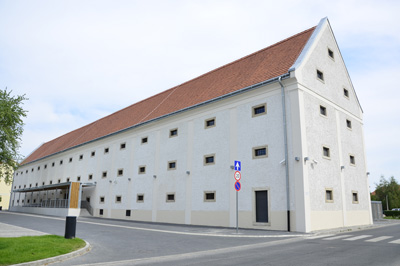 FUTURA was opened to the public on 17th of August 2012. In the nearly 300 year old building that used to be a granary before, an interactive natural science centre was established, where visitors can get familiar with the natural sciences through the four elements: water, air, earth and fire. The hundred year old beams, original walls and earlier equipment of Futura all relate the visitor back to earlier times. Futura is an exciting exhibition which will help children and older visitors to learn while playing interesting and adventurous games.
FUTURA was opened to the public on 17th of August 2012. In the nearly 300 year old building that used to be a granary before, an interactive natural science centre was established, where visitors can get familiar with the natural sciences through the four elements: water, air, earth and fire. The hundred year old beams, original walls and earlier equipment of Futura all relate the visitor back to earlier times. Futura is an exciting exhibition which will help children and older visitors to learn while playing interesting and adventurous games.
Ground floor – Water
The ground floor of the building shows different aspects of water. This natural element characterizes the region the most. A “playground” was created here, where many exciting elements can be found and different characteristics of water are demonstrated by the water and its related objects. All this is integrated into a realistic relief model: mountain, glacier, river valleys, lakes, navigable channels and the sea itself.
First floor – Earth
The building’s first floor can make visitors acquainted with different physical phenomena connected to Earth, the world in general and the wildlife of Szigetköz. All this is discovered in a playful way. The elements of the exhibition - among many others - present visitors the well-known laws of physics like the law of conservation of energy, the principle of gravity and the law of inertia.
Second floor – Air
On this floor visitors can get to know interesting information about the air and the phenomena related to this element. The formative power of wind is demonstrated by a sand desert, where visitors can observe the movement of sand hills and the forming of sand ridges and sand avalanches.
The attic – Fire
The floor dedicated to fire provides opportunity to see and do experiments related to the Sun. As the visitor arrives to the attic, the Dark room unfolds its mysteries. The visitor can experience the strange play of colours and lights.
Szigetköz Adventure Park
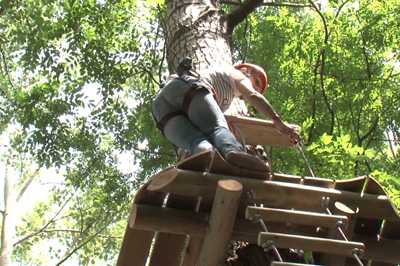 The people who run the adventure park are part of an expert team. One of the members, Gábor Heincz is an experienced adventure park builder and has participated in building several adventure parks in Hungary. He has also run another adventure park in Western-Hungary for years. His partner, the biker Ákos Varga has shown his endurance and love of the extreme programmes several times. He has successfully finished the Dakar Rally twice.
The people who run the adventure park are part of an expert team. One of the members, Gábor Heincz is an experienced adventure park builder and has participated in building several adventure parks in Hungary. He has also run another adventure park in Western-Hungary for years. His partner, the biker Ákos Varga has shown his endurance and love of the extreme programmes several times. He has successfully finished the Dakar Rally twice.
Their aim is to provide new leisure activities and adventures to those who love active recreation and to enrich the touristic offer of Szigetköz and Mosonmagyaróvár.
They have created a 60 obstacle course on a ca. 1.5 hectare territory in the Rudolf-park. The ropeway in different heights and grades provide an excellent entertainment for all age groups. They have a wide range of lines from baby and children lines and different grades of adult lines. Visitors can even try a slide above the Danube, a climbing wall and a trampoline.
The adventure park is not open every season.
Mosonmagyaróvár is situated at the confluence of the Lajta and the Moson-Danube. Several branches of the Lajta cross the town. However, the town is not known throughout Europe for its natural resources but for the health tourism, mainly for dental treatments. A huge advantage for foreign tourists is that they can be treated for half the price the same treatment would cost in their home countries. Due to the huge demand, the number of dental cabinets is over 100.
 The oldest monument in the town is the castle. The building was surrounded by a moat. You can get into the castle through a bridge made of bricks and a gate-building shaped like a tunnel. The seven gothic sediles served the defenders of the castle. We do not know exactly when the castle was built, but it was reinforced several times. Since there was no source for stones in the area, the building was reinforced by decreasing its height. Its shape must have been a pentagon, but today only an irregular rectangle shape can be seen. The ground floor and the first floor are in baroque style. The second floor was erected for the planned Educational Institute for Economics. The fortress and its surrounding were owned by the Habsburg family. Europe's first agricultural college was established and organized by Kázmér Albert prince of Saxony. The College has functioned more or less continuously through the years. The aim of Kázmér Albert was to provide good education for the people working in his fields. At the entrance of the fortress you can see two busts donated by the local Economist Association. On the left is the bust of the founder Kázmér Albert prince of Saxony, on the right is the bust of the first director, Antal Wittmann.
The oldest monument in the town is the castle. The building was surrounded by a moat. You can get into the castle through a bridge made of bricks and a gate-building shaped like a tunnel. The seven gothic sediles served the defenders of the castle. We do not know exactly when the castle was built, but it was reinforced several times. Since there was no source for stones in the area, the building was reinforced by decreasing its height. Its shape must have been a pentagon, but today only an irregular rectangle shape can be seen. The ground floor and the first floor are in baroque style. The second floor was erected for the planned Educational Institute for Economics. The fortress and its surrounding were owned by the Habsburg family. Europe's first agricultural college was established and organized by Kázmér Albert prince of Saxony. The College has functioned more or less continuously through the years. The aim of Kázmér Albert was to provide good education for the people working in his fields. At the entrance of the fortress you can see two busts donated by the local Economist Association. On the left is the bust of the founder Kázmér Albert prince of Saxony, on the right is the bust of the first director, Antal Wittmann. Deák square was once the market square of Magyaróvár. From the east it is bordered by the mill and the three storey high building of the brewery. The mill is one of the oldest buildings of the town. It was open and working until 1980. The brewery was bought by the Dreher beer-manufacturing company in 1937. It was closed later on. On the other side of the square is the Habsburg palace with its baroque arches in the court. Friedrich Maria Albrecht Wilhelm Karl von Österreich lived in the building from 1920 with his family. Nowadays it houses a Piarist friary and a school. Friedrich of Habsburg lived in this building between 1920 and 1936. He was a very friendly person. As he took long walks every day he stopped and discussed with pedestrians while he was sitting on the bench in front of the palace. For this reason the people of Mosonmagyaróvár remembered him by placing a sitting sculpture of the Archduke on a wedlock bench. The statue was finished in 2006. Another gem of the square is St. John of Nepomuk’s Baroque statue consisting of three figures. St. John of Nepomuk is considered the patron of Czechia. St. John of Nepomuk is considered the first martyr of the seal of the confession.
Deák square was once the market square of Magyaróvár. From the east it is bordered by the mill and the three storey high building of the brewery. The mill is one of the oldest buildings of the town. It was open and working until 1980. The brewery was bought by the Dreher beer-manufacturing company in 1937. It was closed later on. On the other side of the square is the Habsburg palace with its baroque arches in the court. Friedrich Maria Albrecht Wilhelm Karl von Österreich lived in the building from 1920 with his family. Nowadays it houses a Piarist friary and a school. Friedrich of Habsburg lived in this building between 1920 and 1936. He was a very friendly person. As he took long walks every day he stopped and discussed with pedestrians while he was sitting on the bench in front of the palace. For this reason the people of Mosonmagyaróvár remembered him by placing a sitting sculpture of the Archduke on a wedlock bench. The statue was finished in 2006. Another gem of the square is St. John of Nepomuk’s Baroque statue consisting of three figures. St. John of Nepomuk is considered the patron of Czechia. St. John of Nepomuk is considered the first martyr of the seal of the confession.The Cselley-house is the oldest monument building in Mosonmagyaróvár. The building houses the Gyurkovics-collection, which is made up of fine arts and porcelain items. The collection contains 160 paintings from famous painters like Munkácsy and Rippl-Rónai. The Cselley house is part of the Hansági Museum and houses a collection of applied industrial art as well as a Roman lapidary with several tombstones.
 Saint Gotthárd church is an important architectural monument. It was named after an old Bavarian saint. In the nave under the church is the Habsburg-crypt, which is the burial place of the last members of the archduke branch of the family. The crypt has six bays. There are four bells in the tower. These are rather new since the old bells were melted and used for making cannons during the war. One of the mostly decorated parts of the church is the baroque high altar with Corinthian columns, frontispiece in form of a lute, and a group of large sized statues. The high altar is made up of three parts. The statue of the Virgin Mary is situated in the middle of the altar. The upper part of the lute is decorated with the statue of Saint Gotthárd. The gold plated pulpit of the church is decorated with reliefs and statues. The side-altars are dedicated to the lives of Saint Stephen, the Virgin Mary, Christ, the Three Kings and Saint John of Nepomuk.
Saint Gotthárd church is an important architectural monument. It was named after an old Bavarian saint. In the nave under the church is the Habsburg-crypt, which is the burial place of the last members of the archduke branch of the family. The crypt has six bays. There are four bells in the tower. These are rather new since the old bells were melted and used for making cannons during the war. One of the mostly decorated parts of the church is the baroque high altar with Corinthian columns, frontispiece in form of a lute, and a group of large sized statues. The high altar is made up of three parts. The statue of the Virgin Mary is situated in the middle of the altar. The upper part of the lute is decorated with the statue of Saint Gotthárd. The gold plated pulpit of the church is decorated with reliefs and statues. The side-altars are dedicated to the lives of Saint Stephen, the Virgin Mary, Christ, the Three Kings and Saint John of Nepomuk. The Hanság Musem in Mosonmagyaróvár is one of the oldest museums in Hungary. Its first permanent exhibition opened in 1921. Unfortunately most of the collection was destroyed in WWII, but it was reopened soon following demands of local people. Its archaeological collection is made up of items found during excavations made in the area. There are findings from the Bronze Age, and some cemeteries were also found. It has a large collection of ethnographical items. This is the result of research made in the thirties. You can get a glimpse at tools and items connected to traditional crafts in the area like gold-digging, fishing and hunting, as well as traditional furniture and everyday objects from local houses. Donations from local people helped to enlarge the collection presenting local traditions and traditional way of life. Donations made by local craftsmen are the most valuable items.
The Hanság Musem in Mosonmagyaróvár is one of the oldest museums in Hungary. Its first permanent exhibition opened in 1921. Unfortunately most of the collection was destroyed in WWII, but it was reopened soon following demands of local people. Its archaeological collection is made up of items found during excavations made in the area. There are findings from the Bronze Age, and some cemeteries were also found. It has a large collection of ethnographical items. This is the result of research made in the thirties. You can get a glimpse at tools and items connected to traditional crafts in the area like gold-digging, fishing and hunting, as well as traditional furniture and everyday objects from local houses. Donations from local people helped to enlarge the collection presenting local traditions and traditional way of life. Donations made by local craftsmen are the most valuable items.FUTURA
 FUTURA was opened to the public on 17th of August 2012. In the nearly 300 year old building that used to be a granary before, an interactive natural science centre was established, where visitors can get familiar with the natural sciences through the four elements: water, air, earth and fire. The hundred year old beams, original walls and earlier equipment of Futura all relate the visitor back to earlier times. Futura is an exciting exhibition which will help children and older visitors to learn while playing interesting and adventurous games.
FUTURA was opened to the public on 17th of August 2012. In the nearly 300 year old building that used to be a granary before, an interactive natural science centre was established, where visitors can get familiar with the natural sciences through the four elements: water, air, earth and fire. The hundred year old beams, original walls and earlier equipment of Futura all relate the visitor back to earlier times. Futura is an exciting exhibition which will help children and older visitors to learn while playing interesting and adventurous games.Ground floor – Water
The ground floor of the building shows different aspects of water. This natural element characterizes the region the most. A “playground” was created here, where many exciting elements can be found and different characteristics of water are demonstrated by the water and its related objects. All this is integrated into a realistic relief model: mountain, glacier, river valleys, lakes, navigable channels and the sea itself.
First floor – Earth
The building’s first floor can make visitors acquainted with different physical phenomena connected to Earth, the world in general and the wildlife of Szigetköz. All this is discovered in a playful way. The elements of the exhibition - among many others - present visitors the well-known laws of physics like the law of conservation of energy, the principle of gravity and the law of inertia.
Second floor – Air
On this floor visitors can get to know interesting information about the air and the phenomena related to this element. The formative power of wind is demonstrated by a sand desert, where visitors can observe the movement of sand hills and the forming of sand ridges and sand avalanches.
The attic – Fire
The floor dedicated to fire provides opportunity to see and do experiments related to the Sun. As the visitor arrives to the attic, the Dark room unfolds its mysteries. The visitor can experience the strange play of colours and lights.
Szigetköz Adventure Park
 The people who run the adventure park are part of an expert team. One of the members, Gábor Heincz is an experienced adventure park builder and has participated in building several adventure parks in Hungary. He has also run another adventure park in Western-Hungary for years. His partner, the biker Ákos Varga has shown his endurance and love of the extreme programmes several times. He has successfully finished the Dakar Rally twice.
The people who run the adventure park are part of an expert team. One of the members, Gábor Heincz is an experienced adventure park builder and has participated in building several adventure parks in Hungary. He has also run another adventure park in Western-Hungary for years. His partner, the biker Ákos Varga has shown his endurance and love of the extreme programmes several times. He has successfully finished the Dakar Rally twice.Their aim is to provide new leisure activities and adventures to those who love active recreation and to enrich the touristic offer of Szigetköz and Mosonmagyaróvár.
They have created a 60 obstacle course on a ca. 1.5 hectare territory in the Rudolf-park. The ropeway in different heights and grades provide an excellent entertainment for all age groups. They have a wide range of lines from baby and children lines and different grades of adult lines. Visitors can even try a slide above the Danube, a climbing wall and a trampoline.
The adventure park is not open every season.
Győr (distance from Hédervár: 25 km)
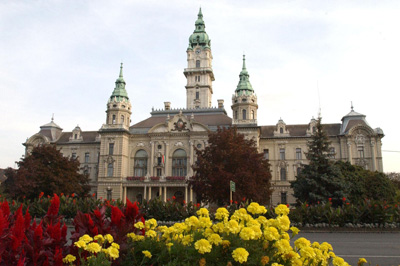 The city (named Arrabona in Latin) is an important economic, industrial, religious, educational, cultural and sport centre. It is situated on the Vienna-Bratislava-Budapest innovative axis, therefore has excellent opportunities for transport and traffic. The city has witnessed one of the fastest and most dynamic developments in Hungary. It is the third richest city in monuments in Hungary. As an acknowledgement of the excellent quality of renovation of the inner city Győr has been awarded the Europe-award for the protection of monuments.
The city (named Arrabona in Latin) is an important economic, industrial, religious, educational, cultural and sport centre. It is situated on the Vienna-Bratislava-Budapest innovative axis, therefore has excellent opportunities for transport and traffic. The city has witnessed one of the fastest and most dynamic developments in Hungary. It is the third richest city in monuments in Hungary. As an acknowledgement of the excellent quality of renovation of the inner city Győr has been awarded the Europe-award for the protection of monuments.The city of Győr has a beautifully arranged, colourful and gentle layout with lots of architectural, cultural and natural values. The city offers excellent opportunities for tourists since there are modern and eclectic public buildings but also a baroque basilica built on Roman foundations.
The ancient churches, palaces, museums, characteristic balconies on corners of the buildings and narrow passageways of the inner city are an irresistible temptation for visitors. Ecclesiastic monuments in Győr and surroundings of Győr are a beautiful memento to thousand years of Christianity in the area. The Basilica and the Bishop’s castle on the Chapter-hill are symbols of Catholic history in the western part of Hungary. Pilgrims flock every year to the Basilica to see the icon of the Virgin Mary which once shed tears of blood. Another sacred treasure of the Basilica is the “Golden head” or the herma of Saint László. The Saint László cult as well as the preservation of traditions established by Benedictine monks in Győr and Pannonhalma is important basis for the development of ecclesiastical tourism in the area.
Győr is also a city of festivals, where visitors can participate in and enjoy programmes of high quality all year round.
The city is almost surrounded by nature, mostly along the rivers that run through the city. Visitors are attracted by the special composition of the local healing water, which resembles the renowned healing water in Héviz due to its high content of sulphur. The newly opened Rába Quelle Bath provides excellent opportunity to relax and enjoy the healing power of thermal water.
Archabbey of Pannonhalma (distance from Hédervár: 45 km)
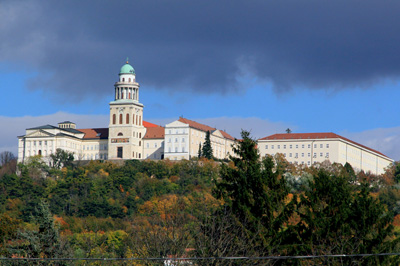 The Benedictine Archabbey of Pannnonhalma is one of the most important historic sites in Hungary. It is both an ecclesiastic as well as a historic and arts centre. The main attraction is the “thousand year old” abbey, which is not only a historical building but also houses many exhibitions and has many collections which are important because of their cultural and historical value.
The Benedictine Archabbey of Pannnonhalma is one of the most important historic sites in Hungary. It is both an ecclesiastic as well as a historic and arts centre. The main attraction is the “thousand year old” abbey, which is not only a historical building but also houses many exhibitions and has many collections which are important because of their cultural and historical value.Works on the building started here in the time of Géza, father of our King Saint Stephen. Some elements of the building ensemble are: basilica and the crypt, Porta Speciosa and the cloister, library, and the baroque dining-hall. It is also worth to visit the Millennial Monument, the Chapel of the Virgin Mary, the Botanical Garden and the Herb garden as well as all other collections scattered around the small settlement.
Beside being a world heritage site, the beauty of the place is also enhanced by the fact that the ensemble of buildings is still actively used by the Benedictine monks for the original purpose even today. Therefore there are some parts of the buildings where access might be temporarily restricted, and only members of the community might be allowed to enter. Everything around here serves the purpose of preservation of the form of living established more than a thousand years ago based on Saint Benedict’s rules.
Benedictine monks prepare and sell herbal teas, lavender products, wines of exceptional quality, liqueurs, chocolate, vinegar and cosmetic products.
Source : http://www.hedervarilovasklub.hu/guesthouse